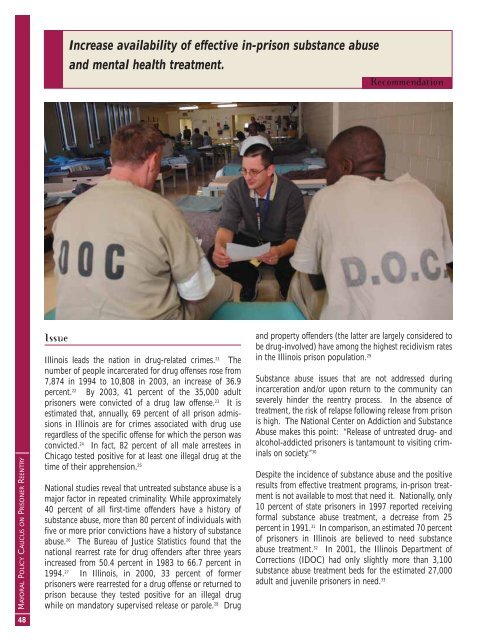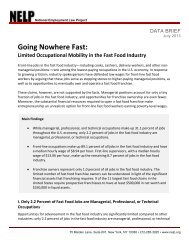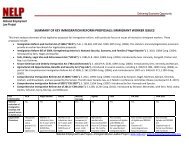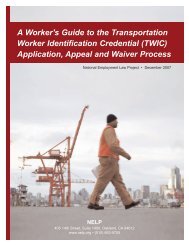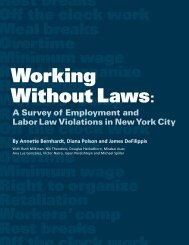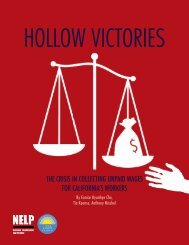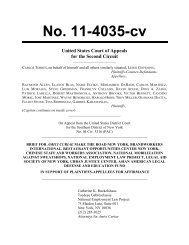Rebuilding Lives. Strengthening Communities.
Rebuilding Lives. Strengthening Communities.
Rebuilding Lives. Strengthening Communities.
You also want an ePaper? Increase the reach of your titles
YUMPU automatically turns print PDFs into web optimized ePapers that Google loves.
Increase availability of effective in-prison substance abuse<br />
and mental health treatment.<br />
Recommendation<br />
MAYORAL POLICY CAUCUS ON PRISONER REENTRY<br />
48<br />
Issue<br />
Illinois leads the nation in drug-related crimes. 21 The<br />
number of people incarcerated for drug offenses rose from<br />
7,874 in 1994 to 10,808 in 2003, an increase of 36.9<br />
percent. 22 By 2003, 41 percent of the 35,000 adult<br />
prisoners were convicted of a drug law offense. 23 It is<br />
estimated that, annually, 69 percent of all prison admissions<br />
in Illinois are for crimes associated with drug use<br />
regardless of the specific offense for which the person was<br />
convicted. 24 In fact, 82 percent of all male arrestees in<br />
Chicago tested positive for at least one illegal drug at the<br />
time of their apprehension. 25<br />
National studies reveal that untreated substance abuse is a<br />
major factor in repeated criminality. While approximately<br />
40 percent of all first-time offenders have a history of<br />
substance abuse, more than 80 percent of individuals with<br />
five or more prior convictions have a history of substance<br />
abuse. 26 The Bureau of Justice Statistics found that the<br />
national rearrest rate for drug offenders after three years<br />
increased from 50.4 percent in 1983 to 66.7 percent in<br />
1994. 27 In Illinois, in 2000, 33 percent of former<br />
prisoners were rearrested for a drug offense or returned to<br />
prison because they tested positive for an illegal drug<br />
while on mandatory supervised release or parole. 28 Drug<br />
and property offenders (the latter are largely considered to<br />
be drug-involved) have among the highest recidivism rates<br />
in the Illinois prison population. 29<br />
Substance abuse issues that are not addressed during<br />
incarceration and/or upon return to the community can<br />
severely hinder the reentry process. In the absence of<br />
treatment, the risk of relapse following release from prison<br />
is high. The National Center on Addiction and Substance<br />
Abuse makes this point: “Release of untreated drug- and<br />
alcohol-addicted prisoners is tantamount to visiting criminals<br />
on society.” 30<br />
Despite the incidence of substance abuse and the positive<br />
results from effective treatment programs, in-prison treatment<br />
is not available to most that need it. Nationally, only<br />
10 percent of state prisoners in 1997 reported receiving<br />
formal substance abuse treatment, a decrease from 25<br />
percent in 1991. 31 In comparison, an estimated 70 percent<br />
of prisoners in Illinois are believed to need substance<br />
abuse treatment. 32 In 2001, the Illinois Department of<br />
Corrections (IDOC) had only slightly more than 3,100<br />
substance abuse treatment beds for the estimated 27,000<br />
adult and juvenile prisoners in need. 33


